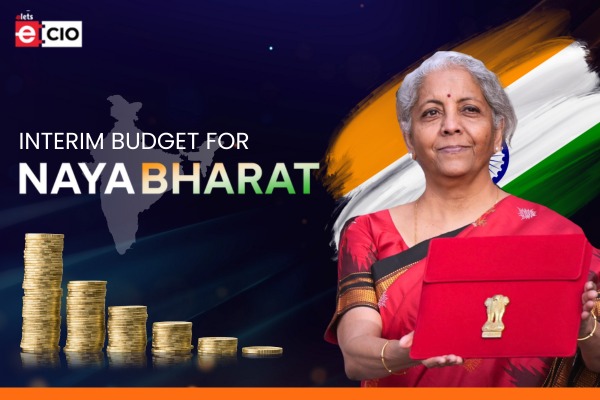
Union Finance Minister Nirmala Sitharaman presented the Interim Budget for 2024-2025, setting India on a path towards ‘Viksit Bharat‘ by 2047. This budget was marked by an ambitious plan for inclusive growth, infrastructure improvement, and strengthening economic stability, highlighting the government’s use of Artificial Intelligence (AI) and strategic planning to overcome global challenges. Under the leadership of Prime Minister Shri Narendra Modi, India embarked on a transformative journey, focusing on strategic reforms and leveraging AI and digital technologies to foster development and social justice. This period saw a commitment to creating opportunities for all layers of society, aiming to make technological advancements and AI central to achieving a sustainable and prosperous future.
India’s Visionary Path to Inclusive and Sustainable Development
India’s journey over the past decade has set a global benchmark in inclusive and sustainable development. The nation’s strategic shift towards comprehensive initiatives has not only met basic needs but has also fuelled economic growth, particularly in rural areas. Here are the key highlights and figures from this transformative journey, as presented in the budget.
Housing and Basic Amenities
- ‘Housing for All’ initiative and ‘Har Ghar Jal’ for universal water access.
- Universal electricity access is achieved nationwide.
- Comprehensive financial inclusion through PM-Jan Dhan accounts, transferring ₹34 lakh crore and saving ₹2.7 lakh crore by reducing leakages.
Social Justice and Inclusivity
- Focus on empowering the poor, women, youth, and farmers.
- Implementation of PM-KISAN SAMMAN Yojana and PM Fasal Bima Yojana, benefiting 11.8 crore farmers and providing crop insurance to 4 crore farmers annually.
Education and Skill Development
- National Education Policy 2020 and Skill India Mission equipping over 1.4 crore youths.
- Significant investments in educational institutions including new IITs, IIMs, and AIIMS.
Women’s Empowerment
- Disbursal of 30 crore Mudra Yojana loans to female entrepreneurs.
- Legislative reforms including the prohibition of ‘Triple Talaq’ and enhanced property ownership under the PM Awas Yojana.
Youth and Sports
- Increased participation of youth in sports, contributing to the nation’s development.
Workforce and Entrepreneurship
- Growing participation of women in the workforce and entrepreneurship.
As India strides towards ‘Viksit Bharat’ by 2047, these initiatives reflect the government’s commitment to Governance, Development, and Performance. This decade-long journey under visionary leadership has significantly reshaped India’s economic landscape and social fabric, heralding an era of prosperity and equality in alignment with the goals of ‘Amrit Kaal’.
Industry Insights
Manos Nikolakis, General Manager – BIC Cello, India
“The government has been continually working to support the education sector. It’s paving the way towards a more prosperous future underlined by innovation, empowerment, and societal advancement by elevating the education infrastructure, skills development programs and digital initiatives. This is evident through budget allocation to the sector as well as key initiatives such as Pradhan Mantri Schools for Rising India (PM-SHRI), and New Education Policy. As a key player and a market leader in the stationery industry, we envision a more equitable future for the upcoming generation if taxation policies on educational materials such as ballpoint and gels pens are reconsidered. This would make education more accessible and affordable for all.”
Anshuman Das, CEO and Co-founder, Careernet
“As we witness the unprecedented pace of infrastructure development in all facets—be it digital, social, or physical—it is evident that the government’s commitment to progress is unwavering. The financial provisions outlined by the Finance Minister signal a paradigm shift, especially in the empowerment of women. With 300 million Mudra Yojana loans, the nation is fostering entrepreneurial spirit, while the remarkable 28% surge in female enrolment in higher education speaks volumes about the strides in education equality. Notably, our optimism is further fuelled by the impressive 43% representation of girls and women in STEM courses, showcasing a commitment to diversity and inclusivity. At Careernet, we embrace this forward momentum, recognising the correlation between education, empowerment, and the rising participation of women in the workforce. This budget sets the stage for a more inclusive and vibrant employment landscape.”
A New Paradigm in Governance
The government has set a new standard for governance, prioritising transparency, accountability, and a citizen-first approach. This model of governance is characterised by
- A significant increase in the average real income of the populace by 50%, indicating substantial economic growth and enhanced living standards.
- The maintenance of moderate inflation, ensuring that the purchasing power of citizens is protected.
- The implementation of policies ensuring effective and timely delivery of programmes and large projects, directly impacting the citizens’ quality of life.
Economic Management and Infrastructure Advancements
The past decade has witnessed remarkable achievements in economic management and infrastructure development, notably
- The rapid construction of physical, digital, and social infrastructure, setting a record in infrastructure development timelines.
- The introduction of Digital Public Infrastructure, revolutionising the economy’s formalisation and efficiency.
- The successful rollout of the Goods and Services Tax (GST), establishing ‘One Nation, One Market, One Tax’, has significantly deepened and widened the tax base.
- Proactive inflation management strategies have kept inflation within the policy band, ensuring economic stability.
Also Read | Live updates Budget: 2024-25 , Here is what Finance Minister says
Global Leadership and Strategic Initiatives
In the face of global challenges, India’s strategic initiatives and leadership have been noteworthy
- During its G20 Presidency, India navigated the global economy through crises of high inflation, high-interest rates, and low growth, among others.
- The announcement of the India-Middle East-Europe Economic Corridor stands out as a major strategic and economic initiative, poised to influence global trade for centuries.
Vision for ‘Viksit Bharat’
The vision for a developed India, ‘Viksit Bharat’, is underpinned by ambitious goals and a strong track record of governance
- The government is committed to realising this vision by 2047, leveraging India’s demographic, democratic, and diverse strengths.
- This vision includes unprecedented development over the next five years, aiming to transform India into a global example of prosperity and harmony with nature.
Empowering MSMEs and Ensuring Energy Security
Special emphasis is placed on empowering Micro, Small, and Medium Enterprises (MSMEs) and achieving energy security
- Policies are being formulated to ensure timely and adequate finances, relevant technologies, and appropriate training for MSMEs.
- The government’s alignment with ‘Panchamrit’ goals aims at sustaining high and resource-efficient economic growth.
Targeted Development Initiatives
The government has launched specific initiatives to catalyse development across various sectors
- Aspirational Districts Programme
Accelerating development in aspirational districts to generate economic opportunities. - PM Awas Yojana (Grameen)
Aiming to build three crore houses, with an additional two crore houses planned for the next five years. - Rooftop Solarisation
Projected savings of fifteen to eighteen thousand rupees annually for households through free solar electricity.
The government’s strategic approach, underscored by these figures and initiatives, reflects a comprehensive effort towards achieving a prosperous, inclusive, and developed nation.
Transforming Healthcare and Medical Education in India
In a significant stride towards enhancing the nation’s healthcare system and medical education, the Indian government has rolled out a series of ambitious initiatives. These measures are designed to bolster the healthcare infrastructure, expand medical education, and ensure the well-being of the population, especially focusing on women and children.
- Expansion of Medical Education
Recognising the high demand for medical professionals, the government plans to increase the number of medical colleges. This expansion leverages existing hospital infrastructures across multiple departments. A specialised committee is appointed to tackle pertinent issues and recommend strategies, ensuring a boost in the supply of qualified medical professionals nationwide. - Cervical Cancer Prevention through Vaccination
A major public health initiative targets cervical cancer, a leading cause of cancer-related deaths in women. The government plans to administer vaccines to girls aged 9 to 14 years. This preventive measure aims to lower cervical cancer rates and instill a preventative healthcare mindset in the population. - Integrated Approach to Maternal and Child Health
The government is consolidating existing schemes into a comprehensive programme to improve maternal and child health. This includes enhancing anganwadi centres under “Saksham Anganwadi and Poshan 2.0”, focusing on nutrition, early childhood care, and holistic development. Additionally, the new U-WIN platform, along with Mission Indradhanush, will advance immunisation programs, ensuring extensive coverage and bolstering public health efforts. - Extended Healthcare Coverage under Ayushman Bharat
In a significant move, healthcare coverage under the Ayushman Bharat scheme is extended to include ASHA workers, Anganwadi Workers, and Helpers. This expansion acknowledges the critical role these frontline workers play in healthcare, especially in underprivileged and rural areas, and aims to provide them with necessary healthcare coverage.
Industry Insights
Koji Wada, Managing Director, FUJIFILM India
“We commend the visionary policies outlined in the interim budget, which will steer our nation towards a healthier future. We laud the administration’s effort towards establishing more medical colleges by leveraging the existing hospital infrastructure, aiming to empower the ambitious youth population who aspire to serve the country through healthcare services. Addressing the crucial aspect of preventive healthcare, a goal that FUJIFILM India also aligns with, we commend the proactive approach of promoting cervical cancer vaccination for young girls to safeguard the well-being of future generations. Moreover, the introduction of the U-Win Platform for the immunization drives is a strategic move towards achieving comprehensive vaccination coverage and ensuring that every citizen receives timely essential vaccinations. The noteworthy extension of Ayushman Bharat cover to Anganwadi and Asha workers also reflects a strong commitment to the well-being of the healthcare workers who tirelessly contribute to the community’s health. In essence, this budget signals a holistic approach to healthcare services, addressing immediate needs while laying the foundation for a robust healthcare system in the coming years.”
Avinash Deshmukh, COO, iThrive
“In this budget announcement, the government has taken a reflective and pragmatic approach, summarizing the achievements of the past decade rather than making bold announcements. This interim budget seems to be a strategic move, avoiding major actions before the upcoming election. The emphasis on continuity and stability is evident, setting the stage for potential impactful measures in the post-election period. The extension of Ayushman Bharat cover to all Anganwadi and Asha workers, along with the consolidation of maternal and child healthcare schemes into a comprehensive initiative, demonstrates a commitment to inclusive healthcare. While it may be viewed as a status quo budget on the surface, it signifies a responsible and measured fiscal strategy, showcasing the government’s dedication to maintaining a positive economic trajectory. The anticipation of more detailed fiscal numbers and micro financial parameters will provide a clearer picture of the country’s economic direction. Overall, the budget lays the foundation for future developments and affirms the government’s confidence in the positive trajectory of the nation.”
Arun Awasthy, President & Managing Director, Johnson Controls India
“The delivery of the Union Budget 2024 by the honorable Finance Minister earlier today can be summed up as stable and focused. The announcement was a clarifying tool that mapped out India’s growth trajectory in the last decade. The verdict is resounding – the Indian Economy has emerged strong, especially after the pandemic, and all signs point towards a continued steady momentum in the future. This year’s budget, in my view, has been drafted to fortify our strengths and ensure that the hard-won momentum remains, with only the most necessary interventions. The Budget also demonstrates a profound and unwavering intent towards achieving India’s NetZero targets through various initiatives, including providing viability gap funding for harnessing offshore wind energy potential and empowering the EV ecosystem by expanding its manufacturing and charging infrastructure. Notable are the announcements made about strengthening the Indian Infrastructure, particularly the expansion of existing airports and plans for newer airports. Our nation’s Infrastructure capacity and capability are growing, and ensuring that it is being done with sustainability and energy efficiency considerations at the center is crucial. We at Johnson Controls India remain steadfastly committed towards enabling India’s transition into decarbonization through meaningful collaboration. Lastly, as we gear up for the full Budget later this year, we expect that concerns of decarbonization through energy-efficient technologies, particularly for buildings, will be on the agenda.”
Transforming India’s Economic Landscape
The budget presented an ambitious blueprint for India’s holistic development, focusing on agriculture, technology, and infrastructure. It underscores the government’s commitment to innovation, empowerment, and economic growth across various sectors.
Agricultural Empowerment and Prosperity
- Enhancing Farmer Income
The Pradhan Mantri Kisan Sampada Yojana has benefited 38 lakh farmers, creating 10 lakh job opportunities. The Pradhan Mantri Formalisation of Micro Food Processing Enterprises Yojana has empowered 2.4 lakh Self-Help Groups and 60,000 individuals. - Post-Harvest Investments
Emphasis on increasing both private and public investment in post-harvest activities. - Nano Technology in Agriculture
Expansion of Nano DAP to various crops across all agro-climatic zones. - Self-Sufficiency in Oil Seeds
The Atmanirbhar Oil Seeds Abhiyan focuses on a range of oil seeds including mustard, groundnut, and soybean. - Dairy Development Programme
Building on existing schemes like the Rashtriya Gokul Mission, this programme aims to enhance productivity in the world’s largest milk-producing nation. - Doubling Fish Production and Exports
The Pradhan Mantri Matsya Sampada Yojana aims to increase aquaculture productivity and double seafood exports to ₹1 lakh crore, creating 55 lakh jobs. - Rural Women Empowerment
The Lakhpati Didi Initiative has enabled nearly one crore women to achieve economic prosperity, with an enhanced target of reaching 3 crore women.
Industry Insights
CA Aditya Sesh, Founder and Managing director of Basiz Fund Service Private Limited and also a Member of the Expert Committee in the Ministry of Agriculture & Farmers Welfare in the Government of India.
“I think of this budget in two dimensions, one being political, which is most important given the election year, and much of the work done has been discussed. It focuses on performance rather than promises. One thing that struck me is that while free electricity has been discussed in some states, here it has been achieved with minimal impact on electricity-generating companies by utilizing solar rooftop resources, essentially providing up to 300 units of electricity to households. The fiscal deficit target, currently at 5.8%, is expected to decrease to 5.1%, primarily due to maintaining the expenditure target well and ensuring that revenue collection, especially tax collection, has been on or even exceeded targets most of the time, purely through compliance. I still remember the 2016 Budget, which had GST and sales tax at 85,000 crores per month, now doubling to 1,65,000 crores per month, so that’s a significant jump. Income tax collection has tripled, indicating that compliance has been maintained without making too many changes to the laws. Over the last 10 years, tax rates for corporates have been reduced from 30% to about 22%. The personal income tax exemption limit has increased from 2.5 lakhs to 7 lakhs. Capex has almost tripled; I think the economy is in very good shape. Capital markets are expected to rise, and India is looking very attractive in terms of growth. The P/E ratios are slightly premium, but that’s because the growth is good, and the inflation management targets are at the desired levels, around 6% odd, matching the increases in GDP, so effectively, there would be no impact on real income.”
Also Read | Interim Budget 2024-25 Unveiled – Emphasis on Inclusive Development & Economic Reforms
Yogesh Mudras, Managing Director, Informa Markets India on Food and Agriculture Sector
“The Food Sector witnesses a transformative stride, post budget. Empowering 11.8 crore farmers with direct financial assistance through PM-KISAN and providing crop insurance to 4 crore farmers under PM Fasal Bima Yojana underscore a strong commitment to agriculture. Additionally, the government’s push to foster private and public investment in post-harvest activities marks a strategic move towards bolstering the entire food supply chain. Exciting times ahead as these initiatives aim to uplift farmers and strengthen the resilience of our food sector.”
Technological Evolution and Economic Growth
- Innovation and Research
A notable allocation of INR 1 lakh crore is dedicated to stimulate research and innovation in sunrise domains. - Infrastructure Development
An 11.1% increase in capital expenditure, totalling INR 11,11,111 crore, signifies the government’s focus on infrastructure as a catalyst for growth. - Railways Revolution
The introduction of three economic railway corridor programmes and the upgrade of 40,000 rail bogies to Vande Bharat standards. - Aviation Sector Expansion
Doubling the number of airports to 149, with Indian carriers ordering over 1000 new aircrafts. - Urban Mobility
Metro Rail and NaMo Bharat projects aim to transform urban mobility and accommodate the needs of growing cities. - These initiatives are poised to enhance livelihoods, stimulate economic growth, and ensure social inclusion, marking a significant step towards a prosperous and self-reliant India.
Industry Insights
Yasir Nazar, Co-Founder, Techno Companion
This budget appears to be relatively conservative, with the Finance Minister placing greater emphasis on reviewing the achievements of the past decade rather than introducing significant changes for the current fiscal year. There are no alterations to the tax slabs, and no major announcements were made. The government exudes confidence in its potential return in the upcoming elections, hinting at a more comprehensive budget unveiling scheduled for July 2024.
Anil Joshi, Managing Partner, Unicorn India Ventures
The interim budget was inline with the expectations. However, startups and sunrise sectors continue to find a special mention even in the interim Budget. The extension of tax exemption to Startups is a good gesture and provision for Rs 1 lakh crore toward sunrise segment at nominal or zero interest rate will certainly help small business. The focus on boosting EV charging station will drive sale of both vehicles and charging infrastructure. No change to direct and indirect tax was also expected, however we may see new rates in full budget to be proposed in July 2024.
Pramod Sharda, CEO of IceWarp India and Middle East
“In the interim budget 2024, Finance Minister Nirmala Sitharaman announced an establishment of ₹1 lakh crore (₹1 trillion) ($12 Billion) with 50-year interest free corpus to help finance research in technology. The corpus will provide long-term financing or re-financing with long tenors and low or nil interest rates. This will encourage the private sector to scale up research and innovation significantly in sunrise domains. This will act an incubator for harnessing and combining the power of Indian Youth and Technology which will further boost the startup culture by creating new techpreneurs in the country.”
Green Energy and Sustainable Development
In a significant move towards environmental sustainability and the ambitious goal of achieving ‘net-zero’ emissions by 2070, several key initiatives focusing on green energy and sustainable development were showcased. These measures reflect a commitment to an eco-friendly future while fostering economic growth.
- Harnessing Offshore Wind Energy
The government has announced viability gap funding for an initial capacity of one giga-watt in offshore wind energy. This initiative aims to enhance the renewable energy sector and boost the green energy portfolio. - Coal Gasification and Liquefaction
A pioneering target has been set to establish a coal gasification and liquefaction capacity of 100 million tonnes (MT) by 2030. This strategy aims to reduce dependency on imported natural gas, methanol, and ammonia, steering towards cleaner energy. - Mandatory Blending of Biogas
The phased mandatory blending of compressed biogas (CBG) with compressed natural gas (CNG) for transport and piped natural gas (PNG) for domestic use is to be mandated, promoting biofuels and reducing greenhouse gas emissions. - Support for Biomass Collection
Financial assistance is to be provided for biomass aggregation machinery, essential for sustainable biomass management and bioenergy production. - Electric Vehicle (EV) Ecosystem Enhancement
The government plans to expand the EV ecosystem, including support for manufacturing, charging infrastructure, and the adoption of e-buses in public transport networks through a payment security mechanism. - Bio-manufacturing and Bio-foundry Scheme
A new scheme will be launched to promote green growth through bio-manufacturing, offering eco-friendly alternatives like biodegradable polymers and bio-pharmaceuticals. - Blue Economy 2.0
This scheme focuses on climate-resilient activities, coastal aquaculture, and mariculture, adopting an integrated approach for the sustainable development of marine resources. - Comprehensive Development of Tourist Centres
Post the G20 meetings, there is a focus on leveraging India’s cultural diversity to boost tourism. States will receive long-term interest-free loans for developing iconic tourist centres. - Promoting Investments and Reforms
The period from 2014 to 2023 witnessed foreign direct investment (FDI) inflows of USD 596 billion. Ongoing negotiations for bilateral investment treaties align with the ‘first develop India’ philosophy. - Societal and Economic Reforms
A high-powered committee will address challenges related to population growth and demographic changes. A provision of seventy-five thousand crore rupees as fifty-year interest-free loans is proposed to support State Governments in reforms. - Amrit Kaal as Kartavya Kaal
Marking the 75th year of India’s Republic, this period is dedicated to national development, with a focus on high economic growth and governance reforms.
These initiatives, forming part of the budget, signify the government’s comprehensive approach towards achieving sustainability, fostering innovation, and promoting economic growth, with a clear focus on green energy, sustainable development, and societal well-being.
Industry Insights
Amit Patjoshi, CEO, Palladium India
“We commend the government’s strong commitment to the agricultural sector evident in the Budget. The focus on value addition and income augmentation for farmers is pivotal, and the success of initiatives like Pradhan Mantri Kisan Sampada Yojana, benefiting 38 lakh farmers, is truly commendable. The support extended through Pradhan Mantri Formalisation of Micro Food Processing Enterprises Yojana, assisting 2.4 lakh SHGs and 60 thousand individuals, reflects a holistic approach towards empowering the agricultural community. The emphasis on reducing postharvest losses and enhancing productivity aligns with the sector’s long-term sustainability. Furthermore, the launch of schemes promoting climate-resilient activities for the blue economy 2.0 is a forward-looking step. This integrated and multi-sectoral approach for coastal aquaculture and mariculture, coupled with restoration and adaptation measures, holds promise for sustainable growth. Overall, this budget signals a positive trajectory for the agricultural sector, laying the foundation for a more resilient and prosperous future.”
Dr. Gopichand Katragadda, President – Institution of Engineering and Technology (IET)
“The Interim Indian Budget released today by Nirmala Sitharaman is forward-looking in parts. It is clear that as we navigate the path of technological leadership for India, the transparency and implementation of deep-tech-related funds presented in the budget become crucial. Ms Sitaraman presented a skills program with an increase in ITI’s. In parallel, the industry’s approach towards talent acquisition must evolve, recognising the value of diploma holders(technicians) alongside STEM graduates, to foster a dynamic workforce. Also, the gender diversity seen in educational institutions has not yet been mirrored in our workforce due to the relative lack of mobility in the female workforce. This calls for a strategic shift of industry hiring to create opportunities in Tier 2 cities and rural areas, particularly in AI, to harness the untapped potential across our nation.
Today’s budget lays down the financial framework, but it’s the execution that will determine our trajectory towards becoming a global tech powerhouse.”
Kush, CEO, Essar Power
“The interim budget 2024-25 has laid a foundation to propel towards reliable, cleaner, greener, and sustainable energy. The government’s commitment to providing free rooftop solar electricity to one crore households, signifies a strategic move towards resource-efficient economic growth. This initiative not only ensures energy security but also stimulates entrepreneurship and employment in the evolving renewable energy landscape.”
India’s Fiscal and Tax Reform Highlights
India’s fiscal landscape has seen substantial shifts in the Revised Estimates for 2023-24 and the Budget Projections for 2024-25, reflecting a strategic approach towards economic growth and stability.
Key Highlights for 2023-24
- Total receipts, excluding borrowings, are set at ₹27.56 lakh crore, with tax receipts at ₹23.24 lakh crore.
- Expenditure for 2023-24 is earmarked at ₹44.90 lakh crore.
- Revenue receipts have increased to ₹30.03 lakh crore.
- The fiscal deficit is revised to 5.8% of GDP.
Projections for 2024-25
- Total receipts are anticipated at ₹30.80 lakh crore, and expenditure at ₹47.66 lakh crore.
- Tax receipts are forecasted at ₹26.02 lakh crore.
- Fiscal deficit for 2024-25 is projected at 5.1% of GDP.
- Gross and net market borrowings are estimated at ₹14.13 lakh crore and ₹11.75 lakh crore, respectively.
The government continues to support states with a scheme offering a fifty-year interest-free loan for capital expenditure, with an outlay of ₹1.3 lakh crore. This initiative is part of a larger journey towards reducing the fiscal deficit to below 4.5% by 2025-26.
Tax System Transformation
The past decade has been remarkable for India’s tax system, with significant reforms in both direct and indirect taxes.
Direct Taxes
- Direct tax collections have more than tripled.
- The number of return filers has increased to 2.4 times.
- Tax exemption limit raised to ₹7 lakh from ₹2.2 lakh.
- Corporate tax rates reduced to 22% for existing companies and 15% for new manufacturing entities.
- Implementation of Faceless Assessment and Appeal and reduction in return processing time from 93 days to just ten days.
Indirect Taxes
- Introduction of Goods and Services Tax (GST), which doubled the tax base and increased the average monthly gross GST collection to ₹1.66 lakh crore.
- State GST revenue increased, with a buoyancy of 1.22 post-GST.
- Significant improvements in customs facilitation, reducing import release times.
Tax Stability and Support
- No changes in current taxation rates for direct and indirect taxes, including import duties.
- Extensions proposed for tax benefits to start-ups and investments by sovereign wealth or pension funds.
- Withdrawal of outstanding direct tax demands up to ₹25,000 for the period up to FY 2009-10 and up to ₹10,000 for FYs 2010-11 to 2014-15.
These fiscal and tax reforms underline India’s commitment to maintaining fiscal prudence, enhancing revenue generation, and supporting sustainable economic growth, amidst a dynamically evolving global economic landscape.
Industry Insights
Gurjodhpal Singh, CEO, Tide India
“We commend the government’s continuous support towards making women the part of the formal economy across sectors from agriculture to entrepreneurship. Recognizing this crucial contribution, today’s budget clearly showed the focus of the government of India towards empowering women for the economic development of the country. To encourage them and start their own businesses, the Mudra Yojana scheme has been a game-changer, providing loans to 30 crore women. This will bridge the digital divide and help women entrepreneurs to equip with the tools they need to compete in the modern marketplace. The empowerment of women through entrepreneurship, ease of living, and dignity for them has gained momentum in the past few years. The continuous government support for women will help them to take centre stage in the sustainable growth of the country. To transform the rural socio-economic landscape with empowerment and self-reliance, the GOI will enhance the target for ‘Lakhpati Didi’ from 2 crore to 3 crore. We believe Indian fintech’s will help women-led MSMEs to access formal credit lines while saving time and money through digitisation and to unlock their immense potential to drive India’s economic growth.”
Sarbvir Singh, Joint Group CEO, PB Fintech
“The transformative initiatives outlined in the Interim Budget 2024 are a monumental leap towards a progressive India. The vision of developed India or Viksit Bharat by 2047 aims to improve people’s capabilities and empower them to build a self-reliant nation. The launch of Amrit Kaal heralded a new era of sustainable and inclusive development and steered India towards economic prosperity. By focusing on the welfare and upliftment of key population segments like women, underprivileged, farmers and the youth, we have set a clear roadmap for the country’s development. Embracing the ‘Digital India’ initiative propels us into a global digital forefront. Our commitment sparks a revolution in connectivity, accessibility, and innovation, paving the way for a tech-powered future. As a country, we continue on the path of fiscal consolidation to ensure that the economy is financially prudent which reflects a positive sentiment for the nation’s economic outlook. Together, these strategic steps fortify our resolve to build India into an innovative and empowered country.”
Looking Forward
India’s resolute commitment to inclusive and sustainable development, economic growth, and the transition to green energy shines brilliantly through the visionary and strategic budget presented. With an unwavering focus on empowering all segments of society, fortifying healthcare, and catalyzing economic reforms, the government’s forward-thinking approach charts an inspiring course towards ‘Viksit Bharat’ by 2047. These comprehensive initiatives underscore a steadfast dedication to prosperity, equality, and environmental sustainability, heralding a new era of progress and well-being for the nation, where the horizons of a brighter, more equitable, and greener future appear boundless and inviting.
Be a part of Elets Collaborative Initiatives. Join Us for Upcoming Events and explore business opportunities. Like us on Facebook , connect with us on LinkedIn and follow us on Twitter.
"Exciting news! Elets technomedia is now on WhatsApp Channels Subscribe today by clicking the link and stay updated with the latest insights!" Click here!












